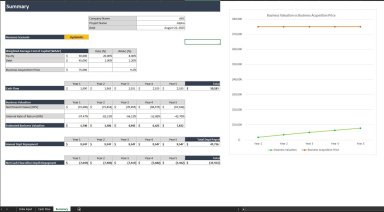
Originally published: 23/08/2023 07:05
Publication number: ELQ-24468-1
View all versions & Certificate
Publication number: ELQ-24468-1
View all versions & Certificate

Business Valuation Spreadsheet
This file enables you to effortlessly compute the Estimated Business Valuation using Net Present Value (NPV) and projected annual cash flow.
Our online platform provides a wide range of engaging and useful templates that cater to various needs.Follow 38
Description
Business Valuation Spreadsheet
This file enables you to effortlessly compute the Estimated Business Valuation using Net Present Value (NPV) and projected annual cash flow. The file accommodates calculations for up to five years and offers three revenue scenarios: Standard, Optimistic, and Pessimistic. Additionally, it provides an option to print the "Summary" sheet in landscape mode.
1. Data Input: This is the sheet where you input all the relevant data. Please fill in the white cells only, as the gray cells are meant for calculations. Navigate to row 70 to address all the questions.
2. Cash Flow: This sheet is fully automated and displays the cash flow per year. There are no manual input cells on this sheet.
3. Summary: This final sheet showcases all the end results. You can choose a Revenue Scenario from the dropdown menu (cell "C8"), with options including Standard, Optimistic, and Pessimistic. The sheet is entirely automated, and there are no manual input cells present.
4. Calculated Parameters: This section includes key calculations such as Weighted Average Cost of Capital (WAAC), Estimated Business Valuation, Annual Debt Repayment, and Cash Flow After Debt Repayment.
Customization Guidelines:
1. Adjust the names in the top section of the "Data Input" sheet (Company Name, Project Name, Created By) to align with your objectives. These names will be automatically reflected in the "Summary" sheet.
2. Modify the names of Operating Expenses in the "Data Input" sheet. You can also add more rows for Operating Expenses if necessary.
3. Refer to the provided video for a comprehensive walkthrough of each step if required.
Key Term Definitions:
- Weighted Average Cost of Capital (WAAC): A calculation that weighs each category of capital to determine a firm's cost of capital. It encompasses various sources of capital, including common stock, preferred stock, bonds, and long-term debt, in the calculation.
- Cash Flow: The net amount of cash and cash-equivalents moving into and out of a business.
- Internal Rate of Return (IRR): A financial analysis metric estimating the profitability of potential investments. IRR is the discount rate that makes the Net Present Value (NPV) of all cash flows zero in a discounted cash flow analysis.
- Net Present Value (NPV): A method used to ascertain the current value of all future cash flows generated by a project, including the initial capital investment. It aids in evaluating projects likely to yield the highest profit.
- Return on Equity (ROE): A measure of a business's profitability relative to equity. ROE indicates the profit generated for each dollar of shareholder's equity.
Business Valuation Spreadsheet
This file enables you to effortlessly compute the Estimated Business Valuation using Net Present Value (NPV) and projected annual cash flow. The file accommodates calculations for up to five years and offers three revenue scenarios: Standard, Optimistic, and Pessimistic. Additionally, it provides an option to print the "Summary" sheet in landscape mode.
1. Data Input: This is the sheet where you input all the relevant data. Please fill in the white cells only, as the gray cells are meant for calculations. Navigate to row 70 to address all the questions.
2. Cash Flow: This sheet is fully automated and displays the cash flow per year. There are no manual input cells on this sheet.
3. Summary: This final sheet showcases all the end results. You can choose a Revenue Scenario from the dropdown menu (cell "C8"), with options including Standard, Optimistic, and Pessimistic. The sheet is entirely automated, and there are no manual input cells present.
4. Calculated Parameters: This section includes key calculations such as Weighted Average Cost of Capital (WAAC), Estimated Business Valuation, Annual Debt Repayment, and Cash Flow After Debt Repayment.
Customization Guidelines:
1. Adjust the names in the top section of the "Data Input" sheet (Company Name, Project Name, Created By) to align with your objectives. These names will be automatically reflected in the "Summary" sheet.
2. Modify the names of Operating Expenses in the "Data Input" sheet. You can also add more rows for Operating Expenses if necessary.
3. Refer to the provided video for a comprehensive walkthrough of each step if required.
Key Term Definitions:
- Weighted Average Cost of Capital (WAAC): A calculation that weighs each category of capital to determine a firm's cost of capital. It encompasses various sources of capital, including common stock, preferred stock, bonds, and long-term debt, in the calculation.
- Cash Flow: The net amount of cash and cash-equivalents moving into and out of a business.
- Internal Rate of Return (IRR): A financial analysis metric estimating the profitability of potential investments. IRR is the discount rate that makes the Net Present Value (NPV) of all cash flows zero in a discounted cash flow analysis.
- Net Present Value (NPV): A method used to ascertain the current value of all future cash flows generated by a project, including the initial capital investment. It aids in evaluating projects likely to yield the highest profit.
- Return on Equity (ROE): A measure of a business's profitability relative to equity. ROE indicates the profit generated for each dollar of shareholder's equity.
This Best Practice includes
Excel File



